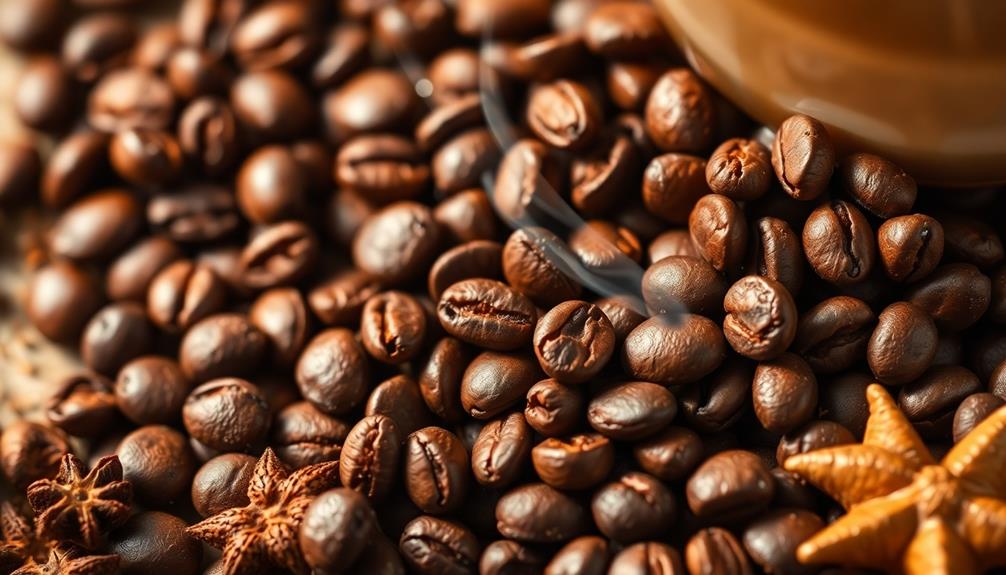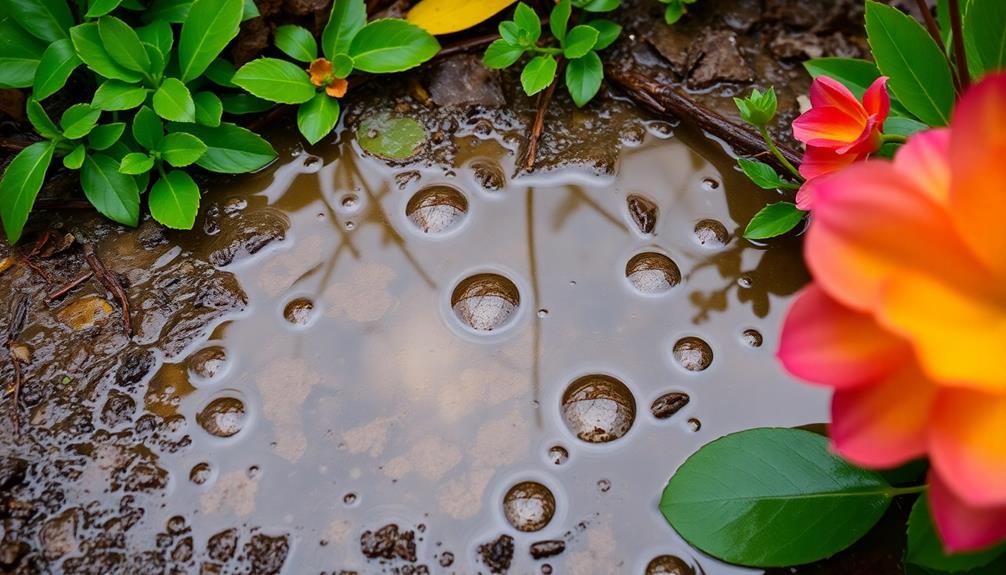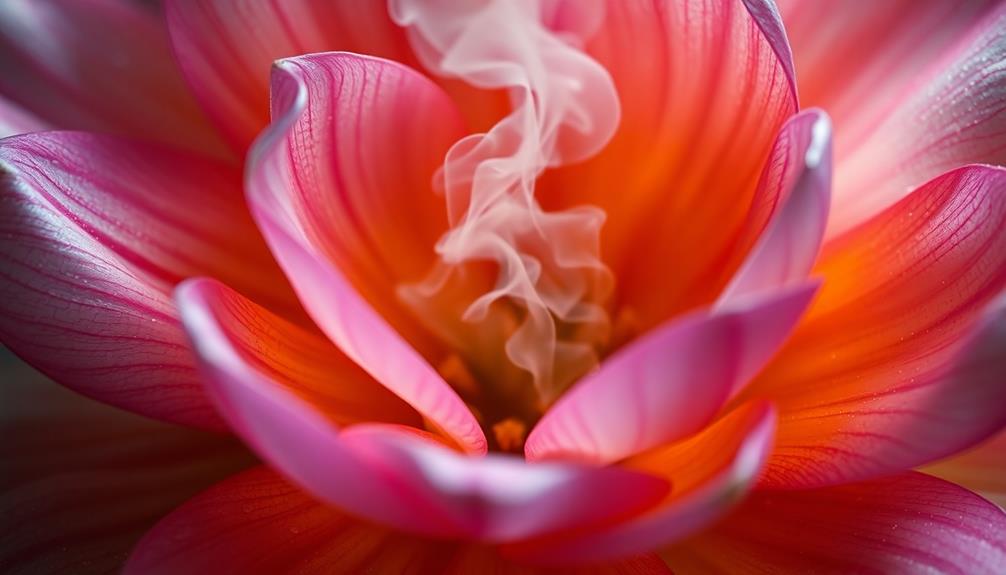When you take a whiff of coffee, you're greeted with a delightful mix of sweet, dark chocolate scents that just pulls you in. If it's freshly roasted, it might also hint at fruity or floral notes, depending on the roast level. Brewing coffee fills the air with rich, bittersweet fragrances that can remind you of baked goodies or cozy mornings. With over 800 aromatic compounds, every cup offers a unique experience. This tantalizing aroma isn't just about smell; it connects you to memories and emotions, making coffee more than just a drink. Keep exploring, and you'll discover even more!
Key Takeaways
- Unbrewed coffee emits a sweet, dark chocolate aroma, inviting exploration of its rich flavors.
- Brewed coffee has a rich and bitter smell, reminiscent of hot chocolate and baked goods.
- Freshly roasted coffee releases a strong aroma that diminishes over time, contributing to its complexity.
- Coffee aroma varies by roast level, with light roasts offering fruity/floral notes and dark roasts presenting smoky fragrances.
- The aroma of coffee enhances enjoyment and evokes emotional connections, memories, and cultural rituals surrounding the beverage.
Introduction

Coffee's aroma is one of its most captivating features, inviting you to experience its rich depths even before the first sip. As you open a bag of freshly roasted coffee, you're greeted by a sweet, dark chocolate scent that's stronger than regular chocolate. It's almost like a warm hug, with subtle floral hints dancing in the air.
This delightful aroma starts its journey during the roasting process, where the magic happens. Interestingly, coffee contains antioxidants that combat oxidative stress, adding to its allure as a healthy beverage.
Each roast level brings its own unique scent. Light roasts might remind you of fruity or floral notes, while dark roasts can feel smoky and bold. When you brew your coffee, the aroma transforms into something even richer, evoking memories of hot chocolate or perhaps burnt cookies baking in the oven.
The influence of coffee aroma on your tasting experience is significant, as it enhances the flavor you perceive. Every cup tells a story, influenced by the coffee's origin and the roasting process.
Description of the Smell

The smell of unbrewed coffee captivates with its sweet, dark chocolate aroma, which often feels more intense than regular chocolate. As you take a deep breath, you might also notice hints of thick, heavy floral notes that float around, adding to the complexity of the coffee aroma.
When brewed, coffee smells rich and bitter, reminiscent of hot chocolate, often triggering memories of burnt cookies and charred chocolate. The delightful scent can also evoke thoughts of seasonal beverages like a Pumpkin Spice Espresso Martini, which blend the aromatic qualities of coffee with festive flavors.
Freshly roasted coffee releases a strong aroma that quickly fades, affecting how you perceive its flavor. You'll find that the roasting level greatly influences the scent. Lighter roasts offer fruity and floral notes, while darker roasts present earthy, bold, and smoky fragrances.
Each time you encounter these scents, remember that over 800 aromatic compounds work together to shape the coffee smells you experience. This is why the aroma of coffee is so important to tasting. It makes every sip more enjoyable and helps you connect with the rich world of coffee.
Source and Composition

Understanding the source and composition of coffee's aroma reveals the complexity behind its captivating scent. When you take a whiff of coffee, you're greeted by a unique blend of over 800 volatile compounds. These compounds, released during the brewing process, create the delightful coffee aroma you love.
Interestingly, much like the rich antioxidants found in celery juice, the volatile compounds in coffee also contribute to its health benefits, making it more than just a delightful scent.
When roasted coffee beans are roasted, their chemical makeup changes dramatically. This transformation enhances their scent through fascinating reactions, like the Maillard reactions and dry distillation.
You might notice that different coffee varieties carry distinct notes, thanks to their plant origins. For instance, some coffees have floral or fruity hints, while others might smell herbaceous.
Freshly roasted coffee has a stronger aroma because it preserves those vital volatile compounds. But be careful! The aroma can fade over time, which affects the overall freshness and scent you experience.
Typical Scenarios or Environments

Wherever you find yourself, the aroma of coffee can create a distinct atmosphere that enhances the experience.
Walk into a bustling coffee shop, and the scent of freshly brewed coffee blends with the delightful fragrances of baked goods. It's a warm invitation, making you feel right at home.
At your kitchen table, the smell of freshly ground coffee beans fills the air, bringing back cozy memories of family gatherings and lazy Sunday mornings. This comforting aroma wraps around you like a soft blanket.
If you're at a coffee tasting, the unique floral and fruity notes of single-origin coffees, like Ethiopian varieties, whisk you away to their lush growing regions.
The rich, smoky scent of beans roasting in a coffee roastery highlights the magic of transformation, turning raw coffee into aromatic brews.
Even in offices or study spaces, the coffee aroma boosts your alertness and focus, helping you tackle tasks with energy.
Each environment offers a different experience, but the essence of coffee brings people together, sparking connections and warm feelings.
Emotional or Cultural Associations

Often, the aroma of coffee triggers deep emotional connections and cultural significance. When you catch a whiff of coffee's aroma, it might remind you of cozy mornings or lively gatherings with friends. That smell of coffee can evoke feelings of warmth and comfort, taking you back to special moments in your life.
Cultural rituals surrounding coffee, like brewing and sharing, make its scent even more meaningful. In many places, coffee isn't just a drink; it symbolizes hospitality and community. When you share a cup with someone, you're connecting on a deeper level.
Did you know that the scent of coffee can actually help you focus? Studies show that it can boost your alertness, making it a staple in daily routines worldwide. Cafes cleverly use coffee's aroma to draw you in, creating an inviting atmosphere that makes you want to linger.
Your preferences for certain coffee aromas might even reflect your cultural identity. Different regions cherish unique scents that resonate with their traditions.
Health or Safety Considerations

The aroma of coffee isn't just delightful; it also brings a range of health and safety considerations worth noting. Inhaling the rich coffee aroma can actually stimulate your brain, enhancing alertness and cognitive function. Imagine walking into a study space filled with that comforting scent—it might just help you focus better!
Moreover, the coffee scent can improve your memory recall and boost mental energy. That's right! Just breathing in the aroma could make those late-night study sessions a bit easier. You might also find that it evokes feelings of warmth and comfort, reducing stress levels and contributing positively to your mental health. Who wouldn't want a little emotional boost?
However, keep in mind some safety considerations. While most people enjoy the smell of coffee, individuals with sensitivities to strong scents might experience headaches or discomfort from prolonged exposure.
Final Thoughts

Enjoying the aroma of coffee can enhance your daily routine, but it also leaves you with much to consider about this beloved beverage. The coffee aroma is a delightful mix of over 800 different scents that come alive as coffee beans are roasted.
Imagine waking up to the rich, bittersweet notes of freshly brewed coffee, reminiscent of dark chocolate, filling your kitchen and waking your senses.
Different types of coffee offer unique aromatic experiences. For instance, lighter roasts bring floral and fruity scents that can transport you to a blooming garden, while darker roasts introduce earthy and smoky fragrances that feel warm and cozy.
But there's more! The smell of fresh coffee can actually boost your mood and help you think better.
Studies show that just inhaling that inviting aroma can improve your mental performance.
Frequently Asked Questions
How Do You Describe a Coffee Smell?
When you describe a coffee smell, think about its layers. You might notice floral hints, nutty undertones, or smoky notes. Each cup tells a story through its aroma, inviting you to savor the experience.
What Kind of Scent Is Coffee?
When you think about coffee's scent, you'll notice its rich, warm aromas. Depending on the roast, it can evoke sweet floral notes, dark chocolate, or even earthy undertones, creating a delightful olfactory experience.
What Is the Fragrant Smell of Coffee?
The fragrant smell of coffee entices you with its rich, complex notes. You'll notice hints of chocolate, nuts, and spices, all blending to evoke warmth and comfort, making each brewing moment a delightful sensory experience.
What Are Words for the Smell of Coffee?
When describing coffee's aroma, you might use words like rich, earthy, floral, smoky, and nutty. These terms capture the complex layers that make up the unique scent, enhancing your appreciation for every brew.









